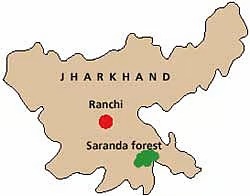Why in the News?
The Supreme Court of India, led by the Chief Justice of India (CJI), directed the Jharkhand government to submit an undertaking to notify a new wildlife sanctuary in the Saranda Forest, West Singhbhum district.

Judicial Background and Case Chronology:
- Origin: Stemmed from NGT’s July 2022 order directing Jharkhand to notify Saranda as a Wildlife Sanctuary or Conservation Reserve.
- Petitioner’s Argument: Claimed Saranda was already a “game sanctuary” (1968, Bihar), deemed protected under the Wildlife (Protection) Act, 1972.
- Non-Compliance: State inaction led the case to the Supreme Court, which between Nov 2024–Sept 2025 repeatedly criticised delay and evasive conduct.
- SC Intervention: CJI D. Y. Chandrachud-led Bench (Apr 16, Sept 17 hearings) condemned “dilly-dallying tactics” and demanded clarity on committees altering sanctuary boundaries in mining belts.
Back2Basics: What is a Wildlife Sanctuary?
|
About Saranda Forest:
- Location: West Singhbhum, Jharkhand; ~856 sq km (816 reserved, rest protected forest).
- Etymology: “Saranda” in Ho language = “seven hundred hills.”
- Vegetation: Dense Sal (Shorea robusta) forests with bamboo, mahua, terminalia; among India’s richest Sal ecosystems.
- Waterbodies: the Karo River and the Koina River.
- Ecological Role: Identified by WII as a biogeographic bridge between Jharkhand and Odisha within the Eastern Himalaya Biodiversity Hotspot.
- Fauna: Asian elephant, four-horned antelope, sloth bear, leopard, civet, diverse birds and butterflies.
- Elephant Corridors: Links to Keonjhar & Sundargarh (OD) and Hasdeo-Arand (CG).
- Threats: Illegal iron/manganese mining, fragmentation, pollution, flagged by Justice M. B. Shah Commission (2014).
- Economic Value: Holds ~26 % of India’s iron ore reserves, mined by SAIL and private lessees.
Significance of Supreme Court’s Ruling (2025):
- Directive: Ordered Jharkhand to notify 31,468 ha (314.68 sq km) of Saranda as a Wildlife Sanctuary, enforcing NGT 2022 order.
- Legal Strengthening: Reinforces Wildlife Act 1972, Forest (Conservation) Act 1980, and Environment (Protection) Act 1986.
- Ecological Impact: Grants protection to Sal canopy, corridors, and watersheds, ensuring habitat connectivity with Odisha.
- Mining Clause: Existing valid leases (e.g., SAIL) remain unaffected, balancing economy and ecology.
- Tribal Safeguards: Upholds rights of Ho & Munda Adivasis under FRA 2006 and PESA 1996.
- Outcome: Sanctuary notification to curb deforestation, revive corridors, and enhance carbon sequestration.
- Precedent Value: Sets national model for reconciling mining, tribal rights, and biodiversity in resource-rich landscapes.
| [UPSC 2018] Consider the following statements:
1. The definition of “Critical Wildlife Habitat” is incorporated in the Forest Rights Act, 2006. 2. For the first time in India, Baigas have been given Habitat Rights. 3. Union Ministry of Environment, Forest and Climate Change officially decides and declares Habitat Rights for Primitive and Vulnerable Tribal Groups in any part of India. Which of the statements given above is/are correct? (a) 1 and 2 only* (b) 2 and 3 only (c) 3 only (d) 1, 2 and 3 |
Get an IAS/IPS ranker as your 1: 1 personal mentor for UPSC 2024

